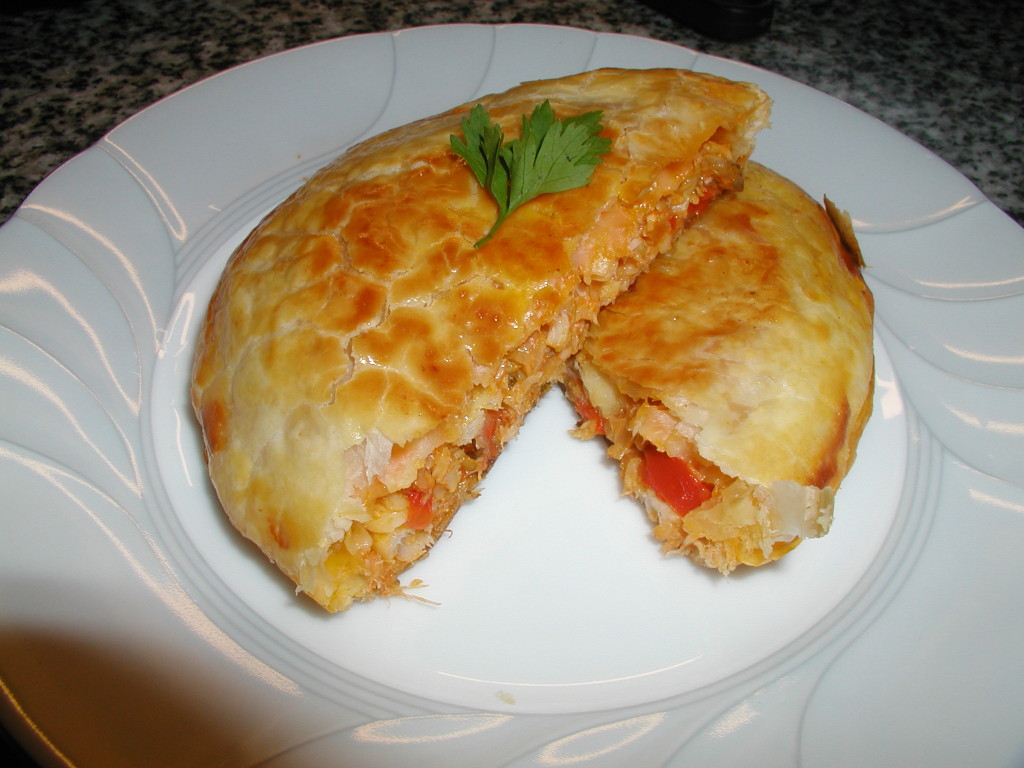On Sunday supplement
Food and Wine
We’re back to the world of empanadas this week, but something a bit different. When it comes down to it, “empanada” really just means “in bread”, a sort of misnomer since it’s usually pastry, not bread, but the point is made. We all know there are numerous varieties, from little teeny cocktail versions that are sometimes served at steakhouses as a nibbling appetizer or passed around at social gatherings, on up to big, fist sized sorts that are more ubiquitous. But it goes past that point – when in Santiago I was told about a local restaurant that places an entire boneless chicken inside of a giant pizza sized dough and bakes it that way, and even here in Argentina, there’s the empanada gallega, originating in Galicia.
Like many such recipes there are more versions of this dish than can be counted – but basically, it’s a pie. The Galician tradition tends towards pork – a mix of sausages and stewed meat, or, cod, often cooked similarly, and generally served up for Lenten, or in the past, Friday suppers. Here in Argentina it’s not surprising that when it’s a meat pie in the making, beef (often accompanied by pork chorizos) is the core ingredient, and when it comes to the fishy variety, the unfortunate use of canned tuna, which for me should be relegated to being mixed with mayo, celery, eggs and slapped on a sandwich (and never again used as a sushi topping, but I digress). I’ve also seen versions using tinned sardines, which delightful as they are on a pizza, are just wrong in a pie. There, I’ve said it.
I make this in one of two versions – I tend to buy the pastry crust – not that it’s hard to make, but they’re so readily available here that there’s little reason to. I either make individual sized ones using standard sized empanada doughs, or I make a pie sized one using the mid-sized doughs for pascualinas. The really big ones are great if you’re having a lot of friends over, but usually a bit much for dinner for the family.
Spiced Fish Pie
1 package of mid-sized pastry crusts or 8 individual empanada tapas
500 gm firm white fish (bass, grouper, cod are good choices), cubed
2-3 slices of serrano ham, chopped
2 white onions, sliced
3 garlic cloves, chopped
1 red bell pepper, chopped
1-2 chilies, chopped
1 large zucchini, sliced
leaves from several sprigs each of oregano and thyme
1 teaspoon each sweet and hot paprika
100 ml dry white wine
salt and black pepper
olive oil
Sauté the onion, garlic, pepper and chili in olive oil with a little salt and pepper until softened, roughly 5 minutes. Add in the zucchini, paprikas and herb leaves and continue cooking, stirring regularly until the zucchini are just softened, another 3-4 minutes. Add the wine and continue to cook until the liquid is mostly absorbed. Remove from heat and combine with the cubed fish (don’t precook it with the mixture or it will be overcooked after baking). Set aside to cool while you prepare the shell.
Oil a pie tin or tart pan and stretch one of the doughs to not only cover the base but also come up the sides with a slight overhang. Or, in the case of individual sized ones, just lay out four of the rounds on an oiled baking sheet. Spoon the fish and vegetable mixture into the shell – use a slotted spoon as we don’t need all the liquid that remains, there will be plenty from cooking the fish and vegetables to perfect done-ness. Pack it in well so that it forms a nice solid filling. Lay the other crust on top and fold in the overhanging edges of the first dough, pinching them together to seal nicely. Cut little vent holes in the top to let steam escape so your pie doesn’t explode in the oven. Bake in a medium hot oven (180°C) for 35-40 minutes until golden brown and bubbling. Remove, cut in wedges and serve. Dinner for 4.
A series of recipes and articles that I started writing for the Buenos Aires Herald Sunday supplement, Food & Wine section, at the beginning of 2012. My original proposal to them was to take local favorite dishes and classics and lighten them up for modern day sensibilities. We’re not talking spa or diet recipes, but at the very least, making them healthier in content, particularly salt, fat and portion size. As time went by, that morphed into a recipe column that, while emphasizing food that is relatively “good for you”, wasn’t necessarily focused on local cuisine. At the beginning of 2013 I decided to stop writing for them over some administrative issues, but it was fun while it lasted.
